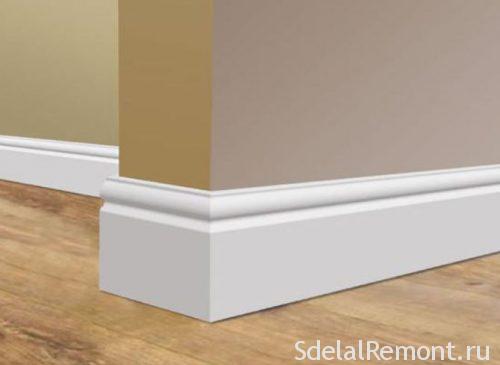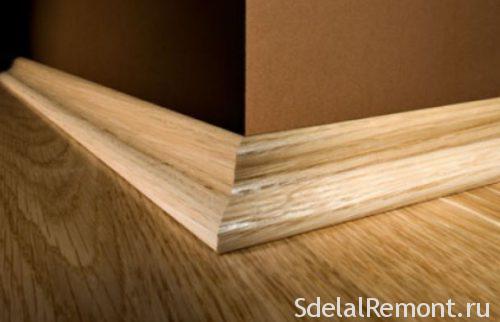- What is the plinth and why it is needed
- Types of skirting boards
- Wooden plinth
- The main advantages of a wooden plinth:
- The main disadvantages
- mounting Features
- veneered baseboards
- mounting Features
- Plastic plinth for floor

- Main advantages:
- Features installation of the plastic plinth
- Plinth made of MDF
- installation
- aluminum plinth
- Polyurethane
- How to choose?
- conclusion
When conducting a floor finish, directly after selecting material, for its arrangement, should consider the types of skirting boards, and also to find a suitable. This material, though small, but quite an important piece of trim, and you can not forget about it. Mounting it directly carried out in the least, but the purchase should be provided at an early stage of repair. note, that from the plinth will largely depend on the aesthetic appearance of the entire room.
What is the plinth and why it is needed
Before you go directly to the selection of a plinth, It should be determined, What is it, and what functions. worth knowing, that the selection of the material depends on the space requirements.
As it has become clear, this part of the interior, as the baseboard, It performs not only a decorative function, but also has a role in the quality and durability of floor. Consider a number of key tasks, which performs this item:
- The first is the insulation of floor. In this way, wooden floors in rooms with high humidity do not swell, and when it is lowered, conversely, do not dry out.
- Also, floor plinth acts as a masking uneven flooring and walls in the docking areas.
- Another function is to hide some communications (often under the plinth hide wires or cables).
- Also useful feature is the creation of a certain transition, to blend in colors of the floor and walls.
- And in the same way, as is the case with color, baseboards create the transition to features textured coatings. Thus, the material or create a contrast therebetween, or combined with registration.

Important! When this item should focus his mind, form, the material from which it is made, and colors.
Types of skirting boards
We now proceed directly to consider the types of plinth. They classify it mainly by material, from which the proceedings are conducted. because, We will dismantle features elements from different materials.
Total distinguish six types, namely:
- Wooden
- veneer
- Plastic
- MDF
- Aluminum
- polyurethane.
And now we will look at each of the types of, their advantages and disadvantages, as well as the installation method.
Wooden plinth
such decoration, made of wood, used in floor laying laminate or parquet. For its production using pine, ale, oak, ash or cherry. For the most part chosen exactly the type of wood, which itself is made of a floor covering.
celebrated, that this kind of elements of the most popular and is represented in the construction market in the broad segment, ranging from economy options, and ending with the premium class.
Presented in a large number of shapes and colors, among the most common is the height of the plinth 6 centimeters with a narrowed bottom portion. It runs smooth cut lines, which gives it an elegant look, Besides helping with the cleaning of rooms.
The main advantages of a wooden plinth:
- Noble origin materials.
- Purity in terms of ecology.
- Durability.
- The high level of strength.
- Good aesthetic quality.
The main disadvantages
- Very high price, which is why they are used only during installation of expensive flooring, eg, parquet.
- There are no recesses, which completely eliminates the wiring without pretreatment.
- After installation, required finishing, and furthermore periodic painting or varnishing.
- Installation is carried out only once, later, after dismantling need to be replaced with new.
mounting Features
wooden plinth must be glued to the flat, clean and dry wall. installation is also possible with the use of the method pristrelivaniya. When laying in the corners is absolutely necessary zapilka.
Important! In order to avoid gaps, installation of this kind requires baseboards create the perfect smooth subfloor and walls.
veneered baseboards
The second kind of plinth marked veneer. It is a slightly modified wood. By itself, it consists of a wooden base, which is further coated with a decorative coating. The coating itself is made of veneer. Also further processed for surface protection lacquer or melamine.
This embodiment is somewhat more popular and the demand, unlike its wooden counterpart. This is because, it is cheaper, wherein the timber can simulate expensive breeds, and in addition it has a wider range of colors.
On many models presented modern construction market, which may take the form of both a natural tree, and its variations (laminated or coated toned). Additionally perform various curved shapes, allowing maximum effectively execute any part of the room, including finishing the round columns or podiums.

Among the advantages noted:
- Environmentally friendly material, because it is made of natural wood.
- Made to order, that provides the ability to pick up the baseboard with precise geometric dimensions.
- Significantly lower cost, making it available.
- Virtually unlimited range of sizes, shapes and colors.
- Most of the models are provided special channels for cable.
But there are inherent disadvantages, namely:
- Low levels of moisture resistance.
- When decorating colors may be differences, that sometimes can spoil the appearance of.
mounting Features
In total there are two methods for installing such an element:
- With the mounting adhesive, As in the case with a standard wooden.
- Installation on a special metal clips.
An important tip! When you purchase this type of skirting board should take into account possible differences of shades, and heterogeneity in pitch of individual elements, as well as their minor visual differences.
Plastic plinth for floor
The most popular and affordable option, a plastic plinth, which is manufactured using PVC foam and used in the laying laminate and linoleum on the floor. There are also plastic baseboards, trims, that you just need to stick to the wall with adhesive tape.
note, that quite a number of the models, both in form, and size similar to natural counterparts. But at the same time there is the availability of channels for mounting and wiring.
Besides, Such models have special slots, which allow you to fix the roll materials (for example, linoleum or carpet). Thus it can be completely pick up the perfect combination with the main floor covering.
Important! It is not desirable to use this type in combination with flooring of natural materials, because they will not look natural and completely spoil the appearance of the premises.
Main advantages:
- It does not require additional processing and special care.
- Have a smooth surface.
- aesthetically beautiful.
- Waterproof.
- They are very resistant to household chemicals.
- Have a sufficiently low cost.
- Have a low weight.
- Presence of the special conduit for wiring can hide them to 5 cables.
Among the disadvantages is necessary to note:
- Not a very high level of strength in the cold in an unheated room.
- It requires the additional use of connectors and plugs, which in turn spoils the appearance of the coating.
Features installation of the plastic plinth
Unlike previous types of installation is carried out covertly by means of special fasteners.
Directly on the back of special channels provided for this purpose. Pre-fixed to the wall bar or the special clips, after which they are inserted into the grooves.
When working with a smooth surface is a floor step mounts meter, in the presence of irregularities provided increasingly.
Considering the process as a small step by step instructions marked as follows:
- In a prepared floor is installed clip.
- Mark places for holes in the wall.
- Further according to the diameter of the dowels are drilled hole.
- The next step is twisted and the screw on his head set clip.
- The last step is to secure the plinth, that is performed by means of clips hitting the slots.
note, that in the end we get a team system, which can be removed and then reinstalled as needed.
Plinth made of MDF
Such a material is a bar MDF, which by its characteristics significantly better fiberboard material, while it is much harder. At the same time, it is easier to process and cheaper. On top of the bar provides the decorative covering, which allows you to simulate any matreialov.
Laminated or MDF, used when laying linoleum or laminate floors. At the same time easy enough to work with him, because due to its strength and flexibility it allows you to completely hide all the defects of the walls and floor.
their benefits is an:
- low cost.
- Resistant to moisture
- Resistance to UV rays and occurrence of contamination.
- Environmentally friendly.
- The availability of special chutes, provided for wiring.
among the shortcomings:
- When processing a large amount of dirt and dust.
- Not resistant to mechanical stress.
installation
Installing MDF baseboards is very simple but requires certain skills and tools.
Yourself installation is carried out by means of special brackets, which are represented in the form of a hook. They are bolted to the wall, then put on top of a plinth. The joints are hidden by special plugs.
This design allows you to remove and re-mount the plinth of the repair or even cleaning.
It is also possible to mount construction adhesive, but it is used less frequently.
aluminum plinth
It is often used in the decoration of office and residential space. Popular thanks to its peculiar, elegant appearance, at the same time it allows you to hide the wiring.
Benefits:
- The high level of strength.
- Easy installation.
- Durability.
disadvantages:
- High price.
- A small assortment.
Installation is carried out on the same principle, as in the case of MDF elements.
Polyurethane
And the last view notes polyurethane. It is used for a long time for sealing joints of the walls and the floor. It boasts excellent performance and aesthetic characteristics, thereby making it a good opponent for wooden elements. Quite often used in environments with high humidity levels.
Benefits:
- Resistant to temperature extremes and its.
- humidity resistant.
- elastic.
- It has an elegant appearance.
disadvantages:
- small range.
- low strength.
At the same time, we note, that presents and shock-segment model, of course of higher value, but now on the second drawback is debatable.
How to choose?
For, to correctly determine the choice of skirting boards, should be guided by such rules:
- The color must fit the color of flooring, doors and walls.
- If the color is slightly different from the color of the floor covering, the interior spaceit will give an additional finished look.
- He should approach the type of flooring and room.
- Skirting boards made of wood may differ from each other in pattern and color.
- You should always take into account the margin for trimming.
- Also consider the characteristics of the premises, and the need for wiring.
conclusion
Now you know what are the types of skirting boards, and now you will be able to select the desired Statement. The important factor is to take into account all our tips and tricks, and, clearly generate goals, to be performed by a plinth, and only if you make the right choice.
And finally, we offer watch a few videos, which more clearly talk about the features of each type and help you make a choice.












